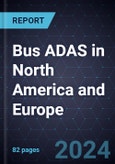Coach Buses to Incorporate Significant ADAS Features while Transit Buses Move Toward Autonomy
The global demand for buses has risen with the increase in capacity and the requirement for faster transfer influenced by economic developments, new business ventures, and changing buying patterns. Fleet operators are exploring advanced technologies, primarily solutions for autonomous buses, to increase efficiency across the supply chain. Although the technologies that make buses completely autonomous remain nascent, the scope of capabilities so far achieved is quite broad. Advanced emergency braking, adaptive cruise control, lane change assist, and reverse assist are some of the features representing the first step toward a working package while individually they act as safety and driver-assist functions that improve both driver and vehicle performance to ensure safer operation and higher productivity.
The industry is well accustomed to SAE Level 1™ and Level 2™ technologies. North America and Europe lead the global transition to autonomous buses, as many industry stakeholders are either based out of or are testing vehicles in these regions. Rudiment's not-exhaustive regulations address functional requirements and are conservative about the deployment of autonomous buses on public roads; they mandate a certain level of safety features for the sale and registration of buses. Industry stakeholders, therefore, require a comprehensive framework and guidance plan to explore, take the next step, and invest suitably in relevant development areas.
This study covers the ADAS market for both transit and coach buses in North America and Europe. The study period is 2022-2030.








